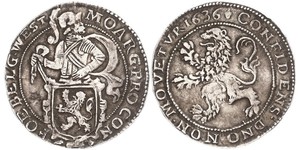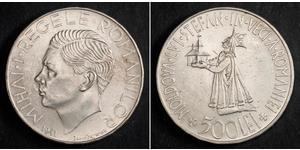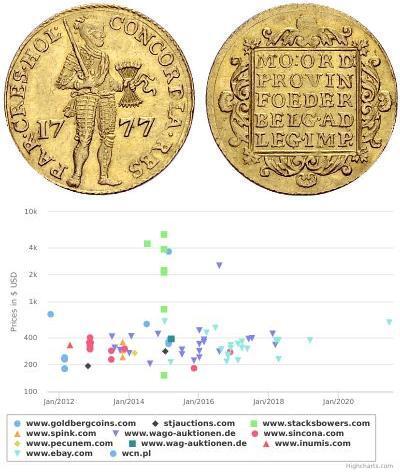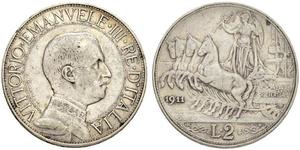(Venduta per $78.0)
1541, Habsburg Netherlands, Brabant, Charles V. Silver Vlieger (4 Stuivers) Coin.
Mint Year: 1541 Reference: vGH 1891-a. R! Denomination: Vlieger (4 Stuivers) Mint Place: Antwerp (privy mark: hand) Ruler: Emperor Charles V (Charles I of Spain) Condition: Minor deposits in reverse, otherwise XF! Diameter: 42mm Weight: 5.63gm Material: Silver
Obverse: Imperial crown above nimate double-headed eagle within inner circle. Legend: KAROLVS x D x G x RO x IMP x Z x HISP x REX x 1541
Reverse: Crowned composite arms with tyrolean eagle at center, surrounded by chain of the Order of the Golden Fleece. Legend: (privy mark: hand) DA MICH x VI RTV x COMES x HOS t VOS
Habsburg Netherlands (Dutch: Habsburgse Nederlanden; French: Pays-Bas des Habsbourg), in Latin referred to as Belgica, is the collective name of Renaissance period fiefs in the Low Countries held by the Holy Roman Empire's House of Habsburg. The rule began in 1482, when the last Valois-Burgundy ruler of the Netherlands, Mary, wife of Maximilian I of Austria, died. Their grandson, Emperor Charles V, was born in the Habsburg Netherlands and made Brussels one of his capitals.
Becoming known as the Seventeen Provinces in 1549, they were held by the Spanish branch of the Habsburgs from 1556, known as the Spanish Netherlands from that time on. In 1581, in the midst of the Dutch Revolt, the Seven United Provinces seceded from the rest of this territory to form the Dutch Republic. The remaining Spanish Southern Netherlands became the Austrian Netherlands in 1714, after Austrian acquisition under the Treaty of Rastatt. Habsburg rule ended with the annexation by the revolutionary French First Republic in 1795.
Charles V (24 February 1500 – 21 September 1558) was Holy Roman Emperor and Archduke of Austria from 1519 to 1556, King of Spain (Castile and Aragon) from 1516 to 1556, and Lord of the Netherlands as titular Duke of Burgundy from 1506 to 1555. As he was head of the rising House of Habsburg during the first half of the 16th century, his dominions in Europe included the Holy Roman Empire, extending from Germany to northern Italy with direct rule over the Austrian hereditary lands and the Burgundian Low Countries, and a unified Spain with its southern Italian kingdoms of Naples, Sicily, and Sardinia. Furthermore, his reign encompassed both the long-lasting Spanish and the short-lived German colonizations of the Americas. The personal union of the European and American territories of Charles V was the first collection of realms labelled "the empire on which the Sun never sets".
Charles was born in the County of Flanders to Philip the Handsome of the Austrian House of Habsburg (son of Maximilian I, Holy Roman Emperor, and Mary of Burgundy) and Joanna the Mad of the Spanish House of Trastámara (daughter of Isabella I of Castile and Ferdinand II of Aragon). The ultimate heir of his four grandparents, he inherited all of his family dominions at a young age. After the death of Philip in 1506, he inherited the Burgundian Netherlands, originally held by his paternal grandmother Mary. In 1516, he became co-monarch of Spain with his mother Joanna, and as such he was the first king of Spain to inherit the country as dynastically unified by the Catholic Monarchs, his maternal grandparents. The Spanish possessions at his accession also included the Castilian West Indies and the Aragonese Kingdoms of Naples, Sicily and Sardinia. At the death of his paternal grandfather Maximilian in 1519, he inherited Austria and was elected to succeed him as Holy Roman Emperor. He adopted the Imperial name of Charles V as his main title, and styled himself as a new Charlemagne.
Charles V revitalized the medieval concept of the universal monarchy and spent most of his life defending the integrity of the Holy Roman Empire from the Protestant Reformation, the expansion of the Ottoman Empire, and a series of wars with France. With no fixed capital city, he made 40 journeys, travelling from country to country; he spent a quarter of his reign on the road. The imperial wars were fought by German Landsknechte, Spanish tercios, Burgundian knights, and Italian condottieri. Charles V borrowed money from German and Italian bankers and, in order to repay such loans, he relied on the proto-capitalist economy of the Low Countries and on the flows of gold and especially silver from South America to Spain, which caused widespread inflation. He ratified the Spanish conquest of the Aztec and Inca empires by the Spanish Conquistadores Hernán Cortés and Francisco Pizarro, as well as the establishment of Klein-Venedig by the German Welser family in search of the legendary El Dorado. In order to consolidate power in his early reign, Charles suppressed two Spanish insurrections (Comuneros' Revolt and Brotherhoods' Revolt) and two German rebellions (Knights' Revolt and Great Peasants' Revolt).
Crowned King in Germany, Charles sided with Pope Leo X and declared Martin Luther an outlaw at the Diet of Worms (1521). The same year Francis I of France, surrounded by the Habsburg possessions, started a conflict in Lombardy that lasted until the Battle of Pavia (1525) led to his temporary imprisonment. The Protestant affair re-emerged in 1527 as Rome was sacked by an army of Charles's mutinous soldiers, largely of Lutheran faith. After his forces left the Papal States, Charles V defended Vienna from the Turks and obtained the coronation as King in Italy by Pope Clement VII. In 1535, he annexed the vacant Duchy of Milan and captured Tunis. Nevertheless, the loss of Buda during the struggle for Hungary and the Algiers expedition in the early 40s frustrated his anti-Ottoman policies. Meanwhile, Charles V had come to an agreement with Pope Paul III for the organisation of the Council of Trent (1545). The refusal of the Lutheran Schmalkaldic League to recognize the council's validity led to a war, won by Charles V with the imprisonment of the Protestant princes. However, Henry II of France offered new support to the Lutheran cause and strengthened a close alliance with the sultan Suleiman the Magnificent, the ruler of the Ottoman Empire since 1520.
Ultimately, Charles V conceded the Peace of Augsburg and abandoned his multi-national project with a series of abdications in 1556 that divided his hereditary and imperial domains between the Spanish Habsburgs headed by his son Philip II of Spain and the Austrian Habsburgs headed by his brother Ferdinand, who was Archduke of Austria in Charles's name since 1521 and the designated successor as emperor since 1531. The Duchy of Milan and the Habsburg Netherlands were left in personal union to the King of Spain, but remained part of the Holy Roman Empire. The two Habsburg dynasties remained allied until the extinction of the Spanish line in 1700. In 1557, Charles retired to the Monastery of Yuste in Extremadura and died there a year later.

1 Thaler Sacro Romano Impero (962-1806) ...
il gruppo ha 10 monete / 10 prezzi
Add coin to this group

1 Daalder Regno d'Olanda (1806 - 1810) / ...
il gruppo ha 180 monete / 161 prezzi
Add coin to this group

1/4 Thaler Confederazione Polacco-Lituan ...
il gruppo ha 12 monete / 8 prezzi
Add coin to this group
2 Lira Kingdom of Italy (1861-1946) Argento Vittorio Emanuel ...
il gruppo ha 28 monete / 24 prezzi
⇑














-300-150-_QkKbzbiMk0AAAFNEbxtvw0E.jpg)






